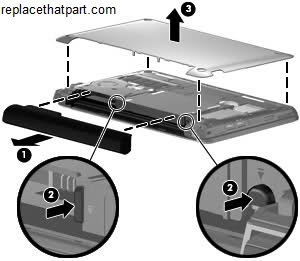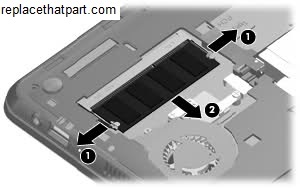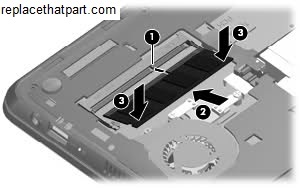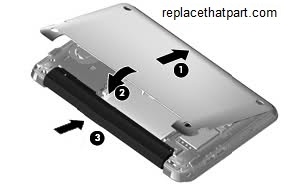
Adding RAM is often the most cost-effective upgrade you can make to speed up a computer. When a computer runs short of RAM, it’s forced to swap the overflow data on and off of the hard drive, which can significantly slow performance. Fortunately, upgrading netbook memory is often one of the easiest computer upgrades. Do you want to get a little more power out of your HP Mini 210 Netbook Pine Trail powered Netbook? Upgrade that 1GB memory module with a 2GB SODIMM. It will speed up opening new applications, running multiple applications at once, and switching between software applications (multi-tasking). Here’s a complete and easy guide on how to upgrade your HP Mini 210 Netbook’s memory.
Purchase the right memory.
Intel Atom N450 (Pineview) based machines can’t access more than 2GB of RAM in total. A 1GB memory module is installed in the memory slot inside your computer. There is, however, only one memory slot on the motherboard, so this means that you’ll have to remove the current RAM module in order to insert a new one. For your HP Mini 210 Netbook you need a standard 200 pin DDR2 SODIMM laptop memory module (not desktop memory). Select a 2GB DDR2 SODIMM memory module of 667MHz or 800MHz. These may be referenced as PC2-5400 or PC2-6400. HP recommends a 667MHz SODIMM. A faster 800MHz stick will also work, but it won’t make a difference in speed as it’s just throttled down to the motherboard bus speed of 667MHz. Recommended memory brands include, but are not limited to, Crucial, Corsair, Kingston, Patriot, Hynix and Viking.
(#ad or paid links)
- Crucial 2GB Single DDR2 667MHz (PC2-5300) CL5 SODIMM 200-Pin Notebook Memory Module CT25664AC667
This is by far the most popular Netbook memory replacement at the moment. - Crucial 2GB Single DDR2 800MHz (PC2-6400) CL6 SODIMM 200-Pin Notebook Memory Module CT25664AC800
- Corsair VS2GSDS667D2 2GB (1x2GB) DDR2 667 MHz (PC2 5300) Laptop Memory
The computer has one memory module compartment, which is located on the bottom of the computer,
beneath the removable bottom panel. There is, however, only one memory slot on the motherboard so this means that you’ll have to remove the current RAM module in order to insert a new one. The procedure to replace the memory is described below.
1. Shut down your Netbook completely.
2. Disconnect all external devices connected to your HP Mini 210.
3. Power off your Mini 210 if it’s on. Also, unplug the AC power adapter.
4. Prepare your Mini 210 by placing it upside-down on a flat surface with some form of soft padding. Static electricity can damage your module and other computer parts. Make sure that you are working in a static-safe environment. Remove any plastic bags or papers from your work space.
5. Remove the battery. This will prevent you from accidentally shorting anything on the system board during this process.
a) Slide the battery release latches (1) to release the battery.
b) Remove the battery (2) from the computer.
6. Discharge residual power by pressing the power button.
7. If your device has WWAN capability, remove the SIM (select models only).
a) Press in on the SIM. The module is partially ejected from the SIM slot.
b) Remove the SIM from the SIM slot.
8. Electrostatic discharge (ESD) can damage electronic components, so be sure to ground yourself. Touch a large or grounded piece of metal (like a tap) for a couple of seconds and you should be fine.
9. Remove the bottom panel:
a. Press the inner release latches (2) on the left and right sides to loosen the bottom panel.
b. Pull away the bottom panel (3).
10.
a) Pull away the retention clips (1) on each side of the memory module. The memory module tilts up.
b) Grasp the edge of the memory module (2), and gently pull the module out of the memory module slot at an angle.
11. Most memory will be sold in a piece of hard, clear plastic. Gently remove the new module from the packaging by pressing on it from the plastic side. Avoid bending the module or applying too much force to the packaging. When you remove the SODIMM memory module from its packaging hold it by the edges, try not to touch the gold colored contacts as this can damage the memory.
12. Insert a new memory module:
a) Align the notched edge (1) of the memory module with the tab in the memory module slot.
b) With the memory module at a 45-degree angle from the surface of the memory module
compartment, press the module (2) into the memory module slot until it is seated.
c) Gently press the memory module (3) down, applying pressure to the left and right edges of
the memory module, until the retention clips snap into place. Make sure the memory module is completely fixed. If the memory does not fit easily, push the memory module down while puling the memory module latches outward. The module should be seated so that you don’t see any of the gold contacts.
13. Replace the removable bottom panel:
a. With the battery bay away from you, position the bottom panel at a 45–degree angle from the
surface of the computer so that the tabs on the underside of the panel align with the matching
slots on the computer (1).
b. Gently press the bottom panel (2) down, applying pressure to both the left and right edges of
the panel, until it snaps into place.
14. Insert your 3G SIM card if you have one.
15. Test it. To install the battery again, slide the battery into the system. Turn your computer back on. The BIOS automatically detects the amount of memory in the system and configures CMOS accordingly during the Power-On Self-Test (POST) process. There is no hardware or software (including BIOS) setup required after the memory is installed. You should see the new amount of memory displayed on your start-up screens or in the properties for “My Computer”. Right click on the “My Computer” icon and select “properties”. The screen which appears should show approximately 2GB of RAM. The memory capacity reported in Windows might be less than the actual capacity of memory. This is because BIOS or the onboard graphics uses a portion of memory or claims it for further use. You can also Hold F10 during start-up. The BIOS Setup Utility screen will open and the System Memory item shows the total amount of memory installed in your netbook. If you have any problems, go to step 16 for troubleshooting tips.
16. Troubleshooting. If you have trouble with your new RAM, check these things first. Check the power cords. Is everything plugged in properly? Check the module. Did both side clips snap to hold the module firmly in place? Try removing the module and replacing it to make sure it is seated properly in the slot. If you’re still having difficulties with your RAM, check the Crucial FAQ section. You may find an easy solution for your problem.
Enjoy!





